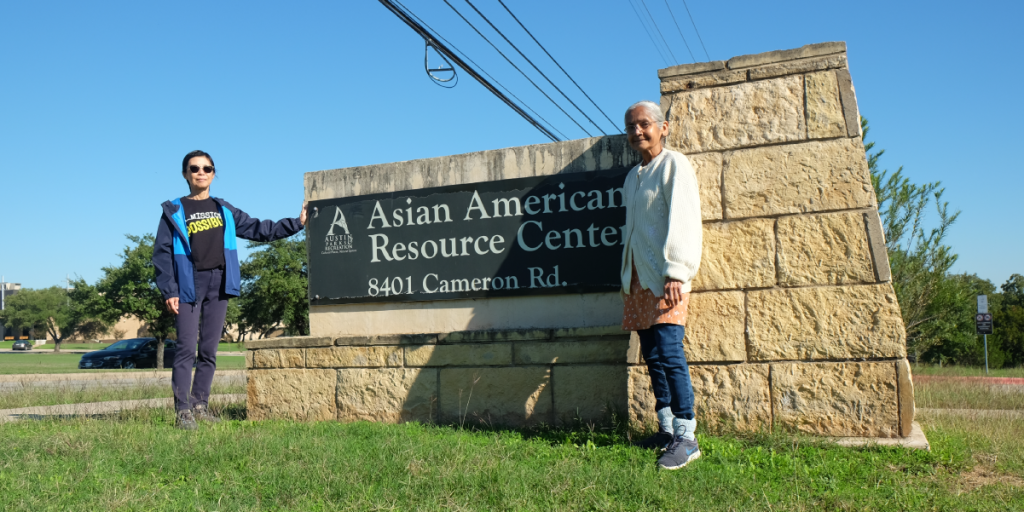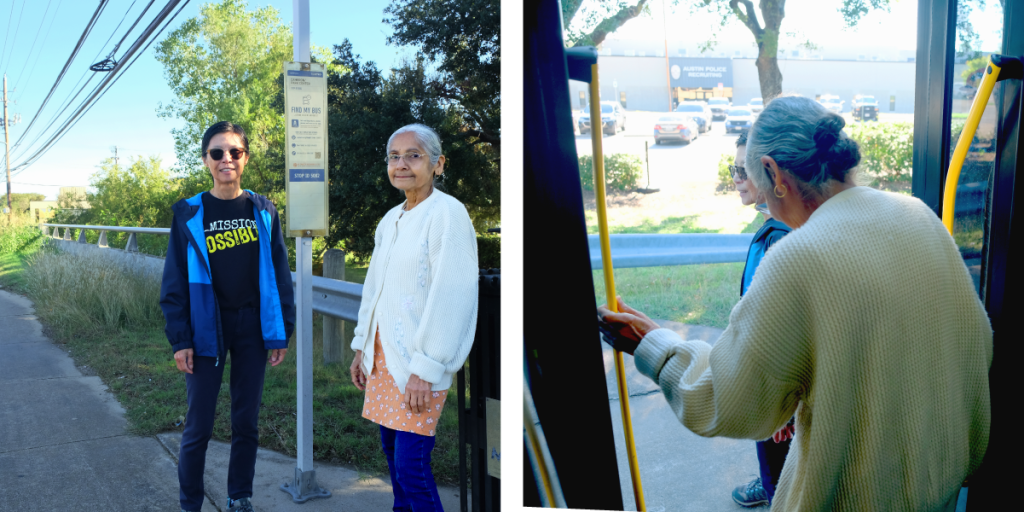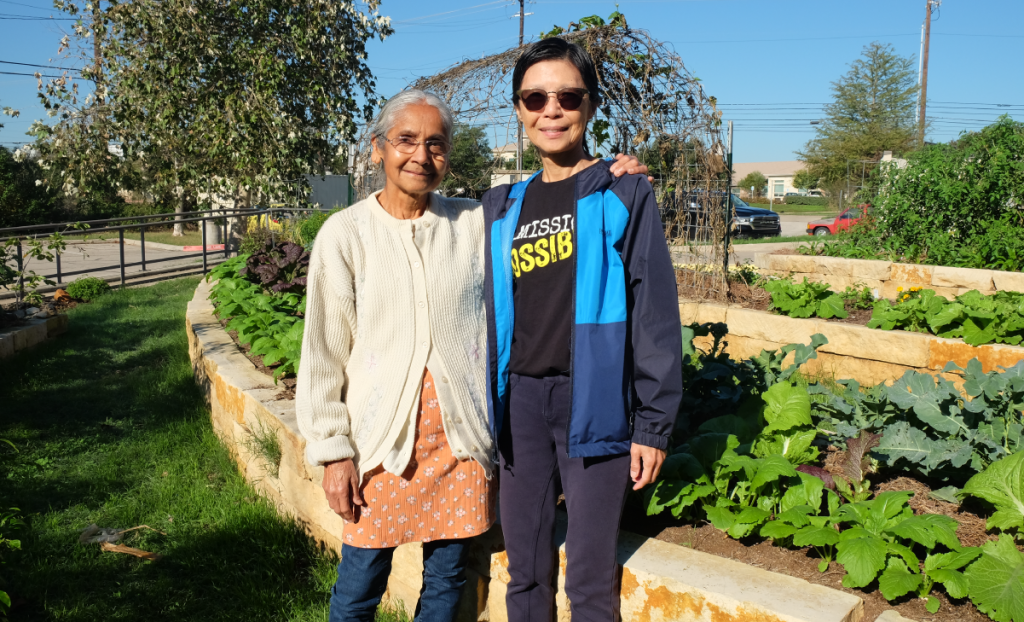Net Zero Heroes: Himadri Patel & Niki Mungcharoen

We’re helping to make Austin Net-Zero by riding the bus or walking instead of driving whenever possible.
Having recently moved to Austin, both Himadri Patel and Niki Mungcharoen were looking for ways to connect with and explore their new community. After meeting at the Asian American Resource Center (AARC), they bonded over being new Austinites and regular bus riders. By learning to navigate public transport, Himadri and Niki have found ways to not only reduce their carbon footprints but also to forge connections and experiences that enrich their lives and inspire others — and for that, we’re excited to introduce them as our newest Net-Zero Heroes.
We recently met with Niki and Himadri at the Asian American Resource Center, where they shared more about their experiences moving to Austin, tips for riding the bus, and some of the ways they’ve forged connections in their new city.
What inspired you to take action?
Himadri: I recently moved to Austin at the age of 73 from Mumbai, India. The move has been about adapting and learning a new way of life. Having lived most of my life in a place that is resource-limited, my way of life has always involved reuse, water and energy conservation, and composting — practices I continue to this day. I always reuse tins and bottles and don’t have a “use-and-throw-away” attitude. I don’t know how to drive, so I take the bus because it is what I always did in my home city. I am lucky it is still an option I have in Austin. I enjoy the freedom of movement the bus brings for me!
Niki: I had a similar experience. I moved to Austin from Orange County, California a little over a year ago to be closer to family. I quickly learned that I could get around to most of the places I needed to go without driving a car. It’s great for the environment and helps me stay active by walking more.
Himadri and I met at the Asian American Resource Center (AARC) while participating in a social activity and a meal. We later learned that we both ride the bus here. We started sharing our know-how about riding the bus.


Above: Niki (left) and Himadri (right) outside the AARC. Below: The women walk to the bus stop together.
Himadri: Yes, Niki and I both enjoy the activities at the AARC, and it was great to learn that Niki took the bus, too! We are able to share knowledge on how to use the CapMetro app or what routes go where, and we sometimes walk to the bus stop together. It was nice to know that someone else also took a bus here. I didn't feel like an anomaly.
How did you do it?
Himadri: Well, learning to take the bus was a journey of its own! I use a combination of Google Maps and the CapMetro app to figure out my route and timings. Learning to read a 2D map to navigate a 3D world at my age was the first challenge, but I did it, and it has been a huge help! Unfamiliar street names and the English language were also challenges to overcome, though minor. In the end, the excitement of having freedom of movement and access to wonderful places like the Asian American Resource Center motivated me to learn.

Niki and Himadri board the bus and greet the driver.
Niki: CapMetro made it easy for me by having a great app. I can plan to go anywhere easily. The app has a Trip Planner to let you know how to get from point A to point B.
Himadri: Exchanging notes with Niki has been great. Niki helped me explore a different bus route than the one I had been using, and it has made my travel easier.
I’m also grateful for the sustainable activities led by AARC. We’ve exchanged plant saplings, and I love that. I’ve gotten curry leaves, garlic, spearmint, night jasmine, and other gardening resources. This brings me so much happiness that the sustainability aspect is almost secondary.

Niki and Himadri explore the AARC Elder Garden.
What’s been most rewarding about getting involved in this way?
Niki: I feel more a part of the community. There can be a feeling of camaraderie while riding the same bus and seeing the same people most days. I’ve actually made friends with a few people who ride the same bus to work.
Himadri: Like Niki, I also meet new people on the bus, and new kinds of friendships are formed. Many times on the bus, other riders will start talking to me in Spanish! I do not speak Spanish, but with our eyes and actions, they tell me stories, I hear them out, and we feel companionship.
The bus drivers are very cooperative, too. Sometimes, I have not yet crossed the street to the bus stop when the bus has arrived. I’ll wave at the driver, and they’ll wait for me, which I really appreciate. One time, I was on the bus and about to miss my stop, but because the driver sees me every day, he alerted me of my stop. I was grateful for it. It is nice to experience the kindness of people while taking the bus.
At my stage in life, I think that if I couldn’t access the city, I would have gotten lost in my thoughts alone at home and maybe even fallen into depression. The bus offers access to so many joys for me, like friends and activities, that keep me physically and mentally agile!

Himadri and Niki pose within a sculpture near the entrance of the AARC.
What’s been the toughest part?
Himadri: The frequency of the buses can be low. If I miss a bus, I am easily late by 30 minutes. Sometimes, buses are canceled, which can make it feel a little unreliable. I once ended up waiting for a bus for over an hour. Usually, I have to take two buses to get where I need to be. Having to switch buses and consider their different schedules adds a lot of time to my travels.
Niki: I’ve definitely experienced that, too. It can be hard when you miss a connecting bus and have to wait a long time for the next one. Or when the weather is not ideal. The 100-degree days in August were really hard this year, as have been the rain storms recently. But I survived!
Himadri: Yes, and some of the stops have very little shelter from the elements. That makes the experience difficult in the extreme seasons of Austin.
Niki: The bus stop closest to the Asian American Resource Center doesn’t have a structure, but we’re lucky to have so many large trees nearby to provide shade for hot days.

Comings and goings. Left: Niki and Himadri wait at the bus stop. Right: The women exit the bus.
Himadri: Also, coming to the Asian American Resource Center requires me to cross Cameron Road. It can feel unnerving. Some of the streets in Austin are not very pedestrian-friendly.
Niki: As much as I feel community on the bus, it's not always rosy. Sometimes, there’s verbal fighting or someone struggling with mental illness talking loudly.
I feel that CapMetro does a good job, but there's always room for improvement. I wish they would try to keep the buses running on time or schedule more buses. The bus I ride daily has a 30-minute frequency, which can make it difficult if you miss one.
If it was more convenient to ride a bus, I think more people would be happy to try our transit system.
Can you share a particularly memorable experience you've had while riding the bus?
Himadri: Yes! There was one time when there was some road construction on my route, so the bus had to take a different route. I was not sure how I was going to make it to my connecting bus. Luckily, when we arrived, there was a CapMetro driver and van at the location. When I shared my predicament, they drove me to the stop for my connecting bus.
Another time, my bus could not continue its route because of an accident, so it was rerouted to a nearby stop. CapMetro had organized a van to be waiting for passengers like me to bring us to an alternate stop. There was a new bus ready at that stop for us to continue on our normal route. CapMetro does its very best to take care of customers.

Niki and Himadri on the bus together.
Niki: My most memorable experiences are with other riders. I once saw a young man eagerly helping a young mother with her child in a stroller and many bags. Many riders on my bus route are traveling somewhere to get free food or other types of support. But you can’t judge a person by the clothes they wear! Riders are always helping each other and let women and children have their seats.
What advice do you have for others?
Niki: I would encourage others in Austin to try riding a bus and give up driving once in a while. I’ve seen and met all kinds of people. Sometimes, it gives you perspective on life and compassion for the less fortunate.
Himadri: I totally agree. It is more economical and eco-friendly to use public transport. I come from a place where public goods like transit are a norm. We pay taxes to have services like mobility. I do not understand why America is so car-oriented.
If slowing down a little can extend the life of our planet, then maybe time and efficiency are not as important as people taking cars make it out to be.

Join Niki and Himadri in celebrating World Sustainable Transport Day on November 26th by planning your own bus ride. Download the CapMetro app or use the online trip planner to map your route. And remember: riding the bus isn’t your only sustainable option! Riding your bike, walking, or taking an e-scooter are also great no- to low-carbon options. To learn more about Austin's net-zero goal and the actions you can take to support a greener community, view the Austin Climate Equity Plan.
Share your Net-Zero contributions with us on Twitter or Facebook, and use #NetZeroHero. If you know a Net-Zero Hero (or heroes!) who should be recognized for their efforts, send your nomination to sustainability@austintexas.gov.
